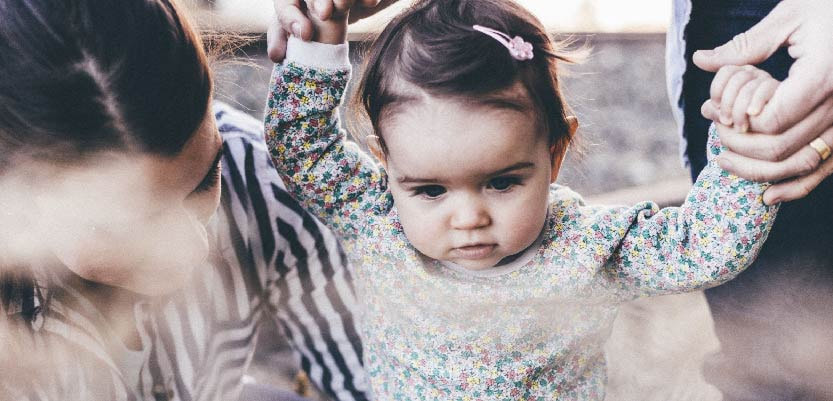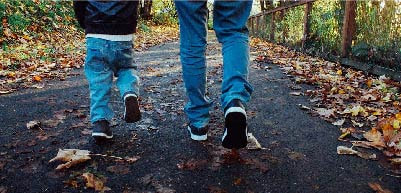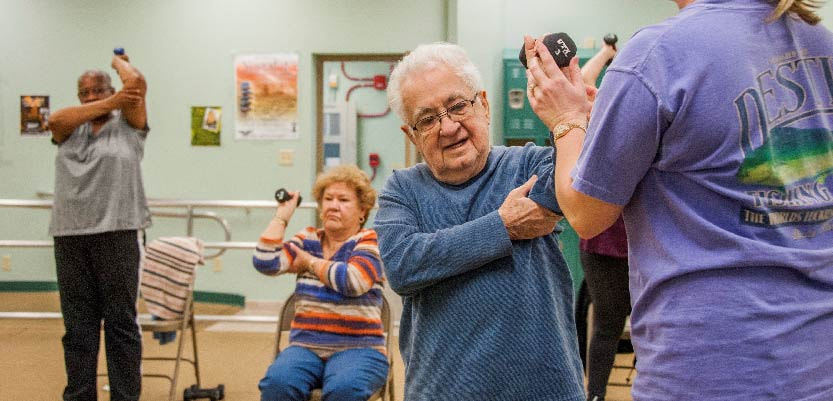The Public Health Department, in collaboration with more than 95 partners in the non-profit, health care and government sectors, this year reached a milestone for San Luis Obispo County: the release of the county’s first comprehensive five-year community health improvement plan.
Together, the partners make up a collaborative known as SLO Health Counts.
“I am thrilled to see this plan in action and especially to see so many organizations from across our community come together to achieve this first for SLO County. I offer my sincere appreciation for the careful thought and hard work that it represents,” said Dr. Penny Borenstein, Health Officer of the County of San Luis Obispo. “This is a true community effort and I hope new partners will continue to join us as we embark on this ambitious plan.”
This five-year plan represents a strategic and collaborative approach to achieving a shared goal: ensuring all San Luis Obispo County residents have the opportunity to be healthy. It provides a path to measurable improvement in eight priority areas.
Those areas and goals are:
Together, the partners make up a collaborative known as SLO Health Counts.
“I am thrilled to see this plan in action and especially to see so many organizations from across our community come together to achieve this first for SLO County. I offer my sincere appreciation for the careful thought and hard work that it represents,” said Dr. Penny Borenstein, Health Officer of the County of San Luis Obispo. “This is a true community effort and I hope new partners will continue to join us as we embark on this ambitious plan.”
This five-year plan represents a strategic and collaborative approach to achieving a shared goal: ensuring all San Luis Obispo County residents have the opportunity to be healthy. It provides a path to measurable improvement in eight priority areas.
Those areas and goals are:
|
Access to Care
|
Social Determinants of Health
|
|
Maternal, Child & Adolescent Health
|
Infectious Disease
|
|
Chronic Disease & Health Behaviors
|
Injuries
|
|
Environment
|
Social & Emotional Wellness
|
The community health improvement plan is informed by the 2018 County of San Luis Obispo Community Health Assessment, which paints a point-in-time picture of the county’s health and highlights the important social, economic and health conditions that affect SLO County.
After sharing this assessment, the Public Health Department brought together partners from across the community to develop a shared vision, identify eight priority areas, and form teams around those priorities. Team members used data, best practices and their own expertise to define goals, develop measurable objectives and outline strategies for the plan.
The resulting community health improvement plan serves as a road map for prioritization and a lens through which to focus on collaboratively-developed statements of highest needs. In some areas, it builds on existing efforts and creates measurable objectives; in other areas, it lays the groundwork for aspirational efforts where the Public Health Department and community partners may either aim limited discretionary funding or seek additional funding sources.
Now, teams are working to put the plan in action. Examples include:
“The true power of this plan is in the diverse partnerships behind each goal,” said Dr. Borenstein. “Working together means we can focus fresh attention on challenging issues and pool expertise and resources to create the greatest collective impact.”
To see the full plan and get involved, visit www.slohealthcounts.org/CHIP.
After sharing this assessment, the Public Health Department brought together partners from across the community to develop a shared vision, identify eight priority areas, and form teams around those priorities. Team members used data, best practices and their own expertise to define goals, develop measurable objectives and outline strategies for the plan.
The resulting community health improvement plan serves as a road map for prioritization and a lens through which to focus on collaboratively-developed statements of highest needs. In some areas, it builds on existing efforts and creates measurable objectives; in other areas, it lays the groundwork for aspirational efforts where the Public Health Department and community partners may either aim limited discretionary funding or seek additional funding sources.
Now, teams are working to put the plan in action. Examples include:
- Bringing together state and local leaders for a regional housing needs summit and helping local agencies develop the methodology for SLO County’s future housing targets;
- Developing educational materials with a specific local angle to help people working in agriculture reduce their risk of Valley Fever and recognize the symptoms if they become sick;
- Equipping parents, educators and teens with up-to-date information on the health effects of vaping and tobacco use;
- Collaborating with the Public Health Institute to facilitate a discussion among health officials and community leaders from San Luis Obispo, Santa Barbara and Monterey Counties on the creation of a Wellness Trust in California and what new, dedicated prevention funds might mean to the emerging work of the collaborative;
- Supporting an increase in the number of dental practices in SLO County that accept Medi-Cal Dental benefits and establishing three “virtual dental homes” where children can receive dental care in their elementary schools.
“The true power of this plan is in the diverse partnerships behind each goal,” said Dr. Borenstein. “Working together means we can focus fresh attention on challenging issues and pool expertise and resources to create the greatest collective impact.”
To see the full plan and get involved, visit www.slohealthcounts.org/CHIP.
Health Care Navigators Take on Tough Questions for County Residents
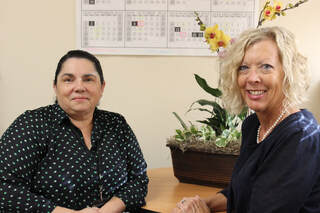
When health care access team members answer the phone, they’re ready for questions that cover the range of human experience with health care, from the logistics to the potentially life-altering: Now that I have insurance, where can I find a doctor? Why is this medical bill so high? I’m worried about this lump—but what if treatment is too expensive?
“No matter what the question or issue is, I want people to know: you’re not alone,” said Laura, a nurse navigator who joined the team this year.
“We’re here to answer their questions,” said Susana, who has served as a patient services representative since 2011. “We help people to see their options … sometimes we can help give them peace of mind, too.”
The team helps connect people with health coverage, including signing up for plans through Covered California, applying for Medi-Cal, or getting short-term emergency assistance through the County’s MISP resources. But that’s often just the beginning.
“It's great to have health insurance, but if you don't understand your plan and how to use it, you will miss out on getting all your health needs met,” Laura said.
And even if you have health insurance, you need to renew it each year. Susana said she often helps residents who didn’t realize they missed a renewal deadline until they found themselves at the doctor’s office without coverage. In those moments of panic, as in other situations, “we’re here to help,” she said.
The team helps SLO County residents find doctors who take their insurance, helps decipher confusing medical bills, and can even serve as a go-between for residents and insurance companies or hospitals in especially complex cases. They also help residents navigate the particulars of public and nonprofit programs—for example, transferring an elderly parent’s hospice services from another county.
There is no typical question, they say, and no typical solution. Their job is to listen carefully and then find an answer.
“I have time to listen and figure out solutions,” Laura said. “It’s not that I know all the answers, but I know how to find things out. And I don’t stop—I keep calling. Because my goal is to come back with something for that person, a solution or an option.”
Susanna said she often connects people with services they didn’t know were available.
“A lot of people don’t know they qualify,” for low-cost or free coverage, she said. “Either they don’t have the information, or they don’t know what information to trust.” In her years in this role, she’s built relationships and trust by consistently offering reliable information and showing up to offer support.
Laura’s career in health care helped prepare her for the challenge. She worked as a nurse for more than 35 years in settings ranging from emergency rooms to home health to community care and more. That experience means she speaks the language of the health care and insurance worlds, and she’s not intimidated by situations that can seem confusing or hopeless from the outside.
Her motivation is simple: “I’m really driven by wanting to make a difference, to address social justice and relieve disparities,” she said. “When I get a tough question, I just think, ‘What if this were my mom? My son? My neighbor?’”
As Susana explains: “It’s a reward seeing that you’re doing something to help.”
In 2018-19, the health care navigation team helped clients complete 197 applications for health care coverage: 63 for the County’s MISP Program, 48 for Covered California and 86 for Medi-Cal. At the same time, they helped County residents navigate a full range of health care challenges, for a total of 1,668 client contacts.
To learn more or get help with a health care question: call 805-781-4838 or visit slocounty.ca.gov/health-care-navigation.
Appointments are available in English or Spanish, over the phone or in person in San Luis Obispo, Grover Beach and Paso Robles.
“No matter what the question or issue is, I want people to know: you’re not alone,” said Laura, a nurse navigator who joined the team this year.
“We’re here to answer their questions,” said Susana, who has served as a patient services representative since 2011. “We help people to see their options … sometimes we can help give them peace of mind, too.”
The team helps connect people with health coverage, including signing up for plans through Covered California, applying for Medi-Cal, or getting short-term emergency assistance through the County’s MISP resources. But that’s often just the beginning.
“It's great to have health insurance, but if you don't understand your plan and how to use it, you will miss out on getting all your health needs met,” Laura said.
And even if you have health insurance, you need to renew it each year. Susana said she often helps residents who didn’t realize they missed a renewal deadline until they found themselves at the doctor’s office without coverage. In those moments of panic, as in other situations, “we’re here to help,” she said.
The team helps SLO County residents find doctors who take their insurance, helps decipher confusing medical bills, and can even serve as a go-between for residents and insurance companies or hospitals in especially complex cases. They also help residents navigate the particulars of public and nonprofit programs—for example, transferring an elderly parent’s hospice services from another county.
There is no typical question, they say, and no typical solution. Their job is to listen carefully and then find an answer.
“I have time to listen and figure out solutions,” Laura said. “It’s not that I know all the answers, but I know how to find things out. And I don’t stop—I keep calling. Because my goal is to come back with something for that person, a solution or an option.”
Susanna said she often connects people with services they didn’t know were available.
“A lot of people don’t know they qualify,” for low-cost or free coverage, she said. “Either they don’t have the information, or they don’t know what information to trust.” In her years in this role, she’s built relationships and trust by consistently offering reliable information and showing up to offer support.
Laura’s career in health care helped prepare her for the challenge. She worked as a nurse for more than 35 years in settings ranging from emergency rooms to home health to community care and more. That experience means she speaks the language of the health care and insurance worlds, and she’s not intimidated by situations that can seem confusing or hopeless from the outside.
Her motivation is simple: “I’m really driven by wanting to make a difference, to address social justice and relieve disparities,” she said. “When I get a tough question, I just think, ‘What if this were my mom? My son? My neighbor?’”
As Susana explains: “It’s a reward seeing that you’re doing something to help.”
In 2018-19, the health care navigation team helped clients complete 197 applications for health care coverage: 63 for the County’s MISP Program, 48 for Covered California and 86 for Medi-Cal. At the same time, they helped County residents navigate a full range of health care challenges, for a total of 1,668 client contacts.
To learn more or get help with a health care question: call 805-781-4838 or visit slocounty.ca.gov/health-care-navigation.
Appointments are available in English or Spanish, over the phone or in person in San Luis Obispo, Grover Beach and Paso Robles.
Making the Connection to Protect People and Animals at the Fair
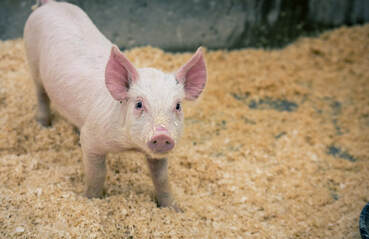
Public Health Department investigation of variant flu leads to new research and recommendations
In early August 2018, a microbiologist working in the County Public Health Laboratory discovered an unexpected result to a routine flu test. Thinking perhaps she’d made a mistake, she worked with her supervisor to carefully repeat the test. The result was the same: the test was positive for influenza, but the specimen did not match strains that commonly circulate among people.
Around the same time, another unusual lab result reached the Public Health Department team. A veterinarian concerned about the spread of illness at the California Mid-State Fair, which had closed just a week earlier in Paso Robles, had performed a necropsy to determine the cause of death for a pig that had died at the fair. The pig tested positive for H1N2 influenza, a type of flu that commonly circulates among pigs.
With this information, the Public Health Department began an investigation that ultimately involved experts from the Centers for Disease Control and Prevention (CDC), international news reports, new research in the field of infectious disease and important recommendations for limiting the spread of influenza.
Launching the Investigation
First, the lab team sent the unusual specimen to the state public health laboratory for confirmatory testing and then on to the CDC for genetic sequencing.
The Public Health Department put out a call to local health care providers requesting that they conduct flu tests for patients with flu-like symptoms and send the results to the public health lab. The lab team went to work testing the specimens that began to arrive.
The epidemiologist and public health nurses began making calls to the family of the patients, to the people who had been in contact with the patients over the past week, and to local doctors who were seeing an unusual number of children with flu-like symptoms in early August.
As the epidemiology team continued their interviews, a pattern became clear: the patients had all spent a lot of time around swine exhibited at the Mid-State Fair. Family members mentioned they thought more pigs than usual had seemed sick. (It’s not unusual for some animals to appear ill under the stress of an agricultural show.)
With these pieces, the central question of the investigation began to take shape: was the virus that killed the pig the same one that was making people sick?
How Does Influenza Affect People and Pigs?
From time to time, influenza viruses can be transmitted from a pig to a person. (In these cases, the virus is referred to as a variant influenza virus infection in people.) This most commonly happens when people have extended close contact with pigs. In recent years, these infections have occurred each summer in the U.S. around agricultural events.
When the virus is transmitted from a pig to a person, it generally does not spread widely to other people. It cannot be transmitted by eating pork. While serious illness is possible, these variant influenza infections are usually mild, with symptoms similar to seasonal flu.
Yet public health teams and infectious disease specialists—from local health departments to the CDC and World Health Organization (WHO)—follow these situations closely. This is in part out of concern that the virus may change in a way that allows it to spread rapidly among people, leading to the next deadly flu pandemic.
Making the Connection with Laboratory Confirmation
In this case, laboratory testing provided a clear answer to the central question: the flu cases were all related, and the virus that made people sick was the same one that killed the sick pig. This virus is common in pigs and on rare occasions can jump to people.
Six people in San Luis Obispo County were diagnosed with laboratory-confirmed variant influenza, H1N2v. (The “v” indicates that the strain is a variant, meaning it typically circulates among animals and in this case has infected a person.) Of these, four exhibited pigs at the fair; one exhibited other animals nearby; and one had no contact with pigs and did not attend the fair, indicating that the virus spread in a limited way from person to person.
In addition to these six laboratory-confirmed cases, the investigation found 67 more probable cases and 117 suspected cases. In these cases, the patients experienced all or some of the signs and symptoms that would meet the clinical definition of flu, and they also had close contact either with swine at the fair or with another sick patient—but they did not get a flu test, so there is no laboratory confirmation that their illness was linked to this outbreak. In many of these cases, the patients had a mild illness and didn’t see a doctor.
The patients all recovered after brief illness.
These six cases were among the first H1N2v cases ever diagnosed in California. Two others were diagnosed around the same time in another California county.
Expanding Research and Recommendations to Protect Health
For the Public Health Department team, the investigation was just beginning. In the weeks and months ahead, the team interviewed 382 people and conducted research in collaboration with the California Department of Public Health and the CDC. For example, the team reviewed the locations within the show barn where people and swine were ill, mapping these in connection with fans and air flow patterns to track the spread of the virus.
Using this analysis along with insight from fair organizers, public health veterinarians and variant flu specialists at the CDC, the Public Health Department developed recommendations to help limit the spread of flu—and the accompanying risk to human and animal health—at agricultural fairs. Later in 2019, CDC will publish the Public Health Department’s research documenting the incident and the resulting recommendations.
Staying Healthy at Animal Exhibits in 2019 and Beyond
Now, the team is working to ensure that people who show animals or attend the fair are as safe as possible from the spread of influenza. The Public Health Department provided recommendations for fair organizers and met with local 4H and FFA groups to talk through tips for staying safe, like washing your hands frequently and making sure not to eat or sleep in the same space with pigs.
This year, the Mid-State Fair is implementing new measures to help protect people and pigs from the flu, including a requirement that all pigs receive the flu shot before entering the agricultural show.
These measures are key. Although this investigation brought in advanced technology for genetic sequencing, the proven techniques for preventing the spread of disease from animals to people are firmly back-to-basics: wash your hands, stay home if you or your animal are sick, call a veterinarian if needed.
With these steps and collaboration across the community, SLO County is well positioned to share knowledge and support to help people and animals stay safe at exhibitions locally and across the nation.
In early August 2018, a microbiologist working in the County Public Health Laboratory discovered an unexpected result to a routine flu test. Thinking perhaps she’d made a mistake, she worked with her supervisor to carefully repeat the test. The result was the same: the test was positive for influenza, but the specimen did not match strains that commonly circulate among people.
Around the same time, another unusual lab result reached the Public Health Department team. A veterinarian concerned about the spread of illness at the California Mid-State Fair, which had closed just a week earlier in Paso Robles, had performed a necropsy to determine the cause of death for a pig that had died at the fair. The pig tested positive for H1N2 influenza, a type of flu that commonly circulates among pigs.
With this information, the Public Health Department began an investigation that ultimately involved experts from the Centers for Disease Control and Prevention (CDC), international news reports, new research in the field of infectious disease and important recommendations for limiting the spread of influenza.
Launching the Investigation
First, the lab team sent the unusual specimen to the state public health laboratory for confirmatory testing and then on to the CDC for genetic sequencing.
The Public Health Department put out a call to local health care providers requesting that they conduct flu tests for patients with flu-like symptoms and send the results to the public health lab. The lab team went to work testing the specimens that began to arrive.
The epidemiologist and public health nurses began making calls to the family of the patients, to the people who had been in contact with the patients over the past week, and to local doctors who were seeing an unusual number of children with flu-like symptoms in early August.
As the epidemiology team continued their interviews, a pattern became clear: the patients had all spent a lot of time around swine exhibited at the Mid-State Fair. Family members mentioned they thought more pigs than usual had seemed sick. (It’s not unusual for some animals to appear ill under the stress of an agricultural show.)
With these pieces, the central question of the investigation began to take shape: was the virus that killed the pig the same one that was making people sick?
How Does Influenza Affect People and Pigs?
From time to time, influenza viruses can be transmitted from a pig to a person. (In these cases, the virus is referred to as a variant influenza virus infection in people.) This most commonly happens when people have extended close contact with pigs. In recent years, these infections have occurred each summer in the U.S. around agricultural events.
When the virus is transmitted from a pig to a person, it generally does not spread widely to other people. It cannot be transmitted by eating pork. While serious illness is possible, these variant influenza infections are usually mild, with symptoms similar to seasonal flu.
Yet public health teams and infectious disease specialists—from local health departments to the CDC and World Health Organization (WHO)—follow these situations closely. This is in part out of concern that the virus may change in a way that allows it to spread rapidly among people, leading to the next deadly flu pandemic.
Making the Connection with Laboratory Confirmation
In this case, laboratory testing provided a clear answer to the central question: the flu cases were all related, and the virus that made people sick was the same one that killed the sick pig. This virus is common in pigs and on rare occasions can jump to people.
Six people in San Luis Obispo County were diagnosed with laboratory-confirmed variant influenza, H1N2v. (The “v” indicates that the strain is a variant, meaning it typically circulates among animals and in this case has infected a person.) Of these, four exhibited pigs at the fair; one exhibited other animals nearby; and one had no contact with pigs and did not attend the fair, indicating that the virus spread in a limited way from person to person.
In addition to these six laboratory-confirmed cases, the investigation found 67 more probable cases and 117 suspected cases. In these cases, the patients experienced all or some of the signs and symptoms that would meet the clinical definition of flu, and they also had close contact either with swine at the fair or with another sick patient—but they did not get a flu test, so there is no laboratory confirmation that their illness was linked to this outbreak. In many of these cases, the patients had a mild illness and didn’t see a doctor.
The patients all recovered after brief illness.
These six cases were among the first H1N2v cases ever diagnosed in California. Two others were diagnosed around the same time in another California county.
Expanding Research and Recommendations to Protect Health
For the Public Health Department team, the investigation was just beginning. In the weeks and months ahead, the team interviewed 382 people and conducted research in collaboration with the California Department of Public Health and the CDC. For example, the team reviewed the locations within the show barn where people and swine were ill, mapping these in connection with fans and air flow patterns to track the spread of the virus.
Using this analysis along with insight from fair organizers, public health veterinarians and variant flu specialists at the CDC, the Public Health Department developed recommendations to help limit the spread of flu—and the accompanying risk to human and animal health—at agricultural fairs. Later in 2019, CDC will publish the Public Health Department’s research documenting the incident and the resulting recommendations.
Staying Healthy at Animal Exhibits in 2019 and Beyond
Now, the team is working to ensure that people who show animals or attend the fair are as safe as possible from the spread of influenza. The Public Health Department provided recommendations for fair organizers and met with local 4H and FFA groups to talk through tips for staying safe, like washing your hands frequently and making sure not to eat or sleep in the same space with pigs.
This year, the Mid-State Fair is implementing new measures to help protect people and pigs from the flu, including a requirement that all pigs receive the flu shot before entering the agricultural show.
These measures are key. Although this investigation brought in advanced technology for genetic sequencing, the proven techniques for preventing the spread of disease from animals to people are firmly back-to-basics: wash your hands, stay home if you or your animal are sick, call a veterinarian if needed.
With these steps and collaboration across the community, SLO County is well positioned to share knowledge and support to help people and animals stay safe at exhibitions locally and across the nation.





